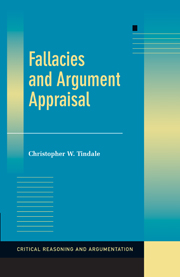Book contents
2 - FALLACIES OF DIVERSION
Published online by Cambridge University Press: 05 June 2012
Summary
Straw Man
For some decades now, argumentation theorists have identified and analysed a fallacious type of argument called the Straw Man fallacy. Although Aristotle makes remarks that suggest a similar concern, the name of the fallacy and its treatment seem modern additions. It is not even mentioned by Hamblin in his seminal work on fallacies. The metaphor captured here reflects a strategy of rebellion or criticism that leads groups of people to build an effigy of a leader (usually with straw) and then attack or burn the effigy, thereby figuratively transferring their “attack” onto the real person. The thinking is that the real person is not available to the group in question and so the effigy serves as a kind of surrogate.
Transferred to the domain of argumentation, this strategy rarely involves any sense of rebellion, but it does retain the tone of a critique and dismissal of whoever or whatever is really at stake. The Straw Man fallacy involves the attribution or assumption of a position, which is then attacked or dismissed. The problem is that the position dismissed by the argument is not the real ‘man’ or ‘person’, but a caricature of the real position held. In a dialogue, a position may be explicitly attributed to an opponent. But for whatever reason, either that position is not one that the opponent actually holds, or the opponent does not hold the position in quite the way that has been attributed.
- Type
- Chapter
- Information
- Fallacies and Argument Appraisal , pp. 19 - 40Publisher: Cambridge University PressPrint publication year: 2007



